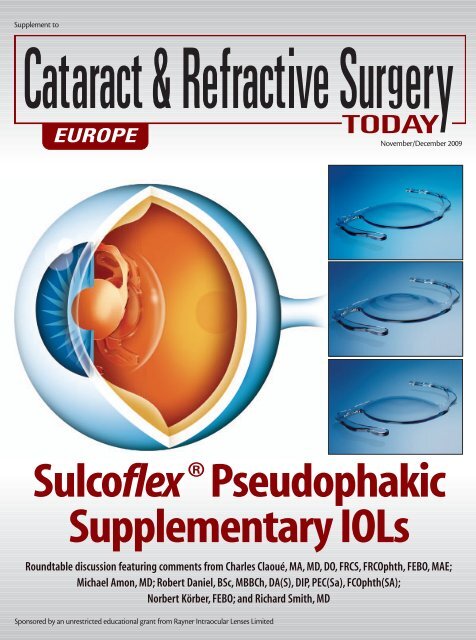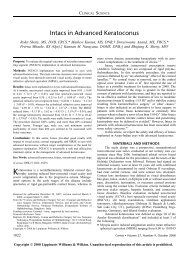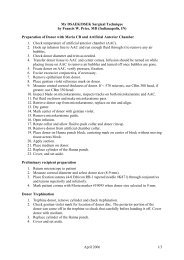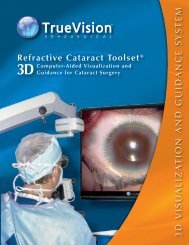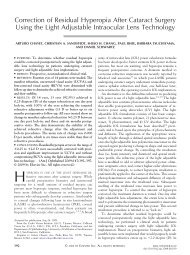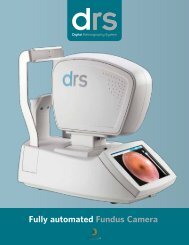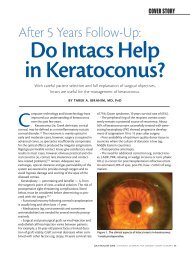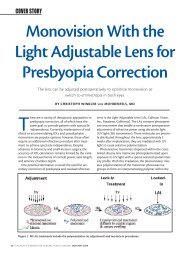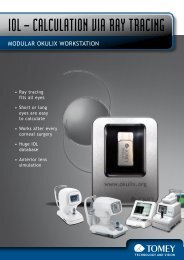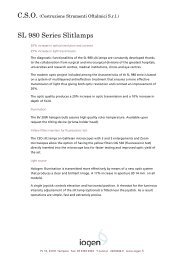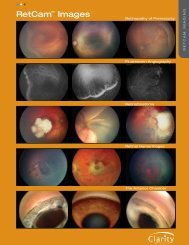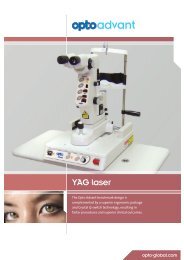Sulcoflex ®Pseudophakic Supplementary IOLs - Iogen
Sulcoflex ®Pseudophakic Supplementary IOLs - Iogen
Sulcoflex ®Pseudophakic Supplementary IOLs - Iogen
You also want an ePaper? Increase the reach of your titles
YUMPU automatically turns print PDFs into web optimized ePapers that Google loves.
Supplement to<br />
Sponsored by an unrestricted educational grant from Rayner Intraocular Lenses Limited<br />
November/December 2009<br />
<strong>Sulcoflex</strong> ® Pseudophakic<br />
<strong>Supplementary</strong> <strong>IOLs</strong><br />
Roundtable discussion featuring comments from Charles Claoué, MA, MD, DO, FRCS, FRCOphth, FEBO, MAE;<br />
Michael Amon, MD; Robert Daniel, BSc, MBBCh, DA(S), DIP, PEC(Sa), FCOphth(SA);<br />
Norbert Körber, FEBO; and Richard Smith, MD
<strong>Sulcoflex</strong>® Pseudophakic <strong>Supplementary</strong> <strong>IOLs</strong><br />
<strong>Sulcoflex</strong>® Pseudophakic<br />
<strong>Supplementary</strong> <strong>IOLs</strong><br />
MODERATOR:<br />
Charles Claoué, MA, MD, DO, FRCS, FRCOphth, FEBO, MAE, is a Consultant Ophthalmologist at<br />
Queen’s Hospital, London, Barking Havering and Redbridge University Hospitals NHS Trust, and in private<br />
practice in London. Mr. Claoué states that he is a consultant to Rayner Intraocular Lenses Limited. He may<br />
be reached at tel: +44 20 88 52 85 22; e-mail: eyes@dbcg.co.uk.<br />
PARTICIPANTS:<br />
Michael Amon, MD, is a Professor and Head<br />
of the Department of Ophthalmology,<br />
Academic Teaching Hospital of St. John,<br />
Vienna, Austria. Dr. Amon is the inventor of<br />
the <strong>Sulcoflex</strong>®. He may be reached at tel: +43<br />
406 99 97; e-mail: amon@augenchirurg.com.<br />
Robert Daniel, BSc, MBBCh, DA(S), DIP,<br />
PEC(Sa), FCOphth(SA), is in private practice<br />
at Morningside Medi-Clinic, Linmeyer, South<br />
Africa. Dr. Daniel states that he has no financial<br />
interest in the products or companies mentioned.<br />
He may be reached at tel: +11 884 5624; fax: +11<br />
783 7649; e-mail: robdaniel@doctors.org.uk.<br />
Cataract surgical outcomes today achieve excellent<br />
refractive results in many cases; however,<br />
when a multifocal or toric enhancement is<br />
desired, or when residual refractive errors do<br />
occur, supplementary <strong>IOLs</strong> are a viable option for correction.<br />
The <strong>Sulcoflex</strong>® (Rayner Intraocular Lenses Limited,<br />
East Sussex, United Kingdom; Figure 1) is designed to provide<br />
multifocality and/or correct postoperative or residual<br />
toric/sphere ametropia without the trauma or increased<br />
surgical risk associated with IOL exchange. When implanted,<br />
the unique IOL design ensures a safe distance between<br />
it and the primary implant (Figure 2), thus reducing<br />
induced refractive errors or aberrations. It also has design<br />
features to make it safe for sulcus placement.<br />
Five surgeons convened in Barcelona, Spain, during the<br />
European Society of Cataract and Refractive Surgeons<br />
(ESCRS) meeting to discuss their clinical experience with<br />
the <strong>Sulcoflex</strong>®. This supplementary IOL is specifically indi-<br />
2 I SUPPLEMENT TO CATARACT & REFRACTIVE SURGERY TODAY EUROPE I NOVEMBER/DECEMBER 2009<br />
Norbert Körber, FEBO, is in private practice<br />
in Cologne, Germany. Dr. Körber states that he<br />
has no financial interest in the products or<br />
companies mentioned. He may be reached at<br />
tel: +49 2203 10 19 70; fax: +49 2203 10 19 729;<br />
e-mail: n.koerber@gmx.de.<br />
Richard Smith, MD, is in private practice in<br />
Sydney, Australia. Dr. Smith states that he has<br />
received financial support from Rayner<br />
Intraocular Lenses Limited to attend and present<br />
his clinical results at an international congress.<br />
He may be reached at e-mail: richardsmith@eyemax.com.au.<br />
cated for the correction of postoperative ametropia,<br />
enhancement after IOL exchange, enhancement of near or<br />
far vision, correction of residual corneal astigmatism, and<br />
correction of refractive changes after pediatric cataract<br />
surgery. Below is a transcript of the discussion on the concept,<br />
design, and considerations for use of the <strong>Sulcoflex</strong>®.<br />
Claoué: Thank you for joining me to discuss the<br />
<strong>Sulcoflex</strong>® supplementary IOL, which is composed of a<br />
proprietary hydrophilic acrylic copolymer that has excellent<br />
uveal biocompatibility. It may be a terrible secret,<br />
but Michael Amon, MD, invented the <strong>Sulcoflex</strong>®. He will<br />
share an introduction to this lens with us.<br />
CONCEPT AND DESIGN<br />
Amon: Thank you, Charles. In the early 90s, surgeons<br />
began piggybacking <strong>IOLs</strong> as a primary implantation strat-
A<br />
C<br />
egy to correct high hyperopia or myopia or as a secondary<br />
surgery when there was a biometric surprise. At that<br />
time, both <strong>IOLs</strong> were implanted into the capsular bag.<br />
This technique caused problems in a lot of cases, namely<br />
interlenticular opacification (ie, opacification as a result<br />
of lens epithelial cell ingrowth on the interface). Another<br />
problem was the contact noted between the central<br />
zones, which occurred when you implanted two biconvex<br />
lenses into the same space. Because of the contact<br />
between the <strong>IOLs</strong>, central flattening and a hyperopic<br />
defocus resulted.<br />
The <strong>Sulcoflex</strong>® presents an exciting<br />
new option for enhancement<br />
of postsurgical results or primary<br />
duet implantation.<br />
—Michael Amon, MD<br />
The <strong>Sulcoflex</strong>® is designed to avoid contact between<br />
the two optical zones. By creating a concave posterior<br />
surface with the second lens, the central zone of contact<br />
is avoidable, as is the hyperopic defocus. The second<br />
thing is that the supplementary IOL is implanted<br />
into the sulcus instead of the capsular bag, which<br />
avoids interlenticular opacification. If a refractive surprise<br />
occurs, use of the <strong>Sulcoflex</strong>® avoids the more<br />
<strong>Sulcoflex</strong>® Pseudophakic <strong>Supplementary</strong> <strong>IOLs</strong><br />
B<br />
Figure 1. The <strong>Sulcoflex</strong>® is available in (A) monofocal<br />
aspheric, (B) multifocal, and (C) toric models. It has an optic<br />
body diameter of 6.5 mm, an overall length of 13.5 mm, and<br />
posterior haptic angulation of 10º. Its optic configuration is<br />
anterior convex, posterior concave.<br />
complicated lens exchange procedure.<br />
As I started doing my first cases with the <strong>Sulcoflex</strong>®, I<br />
realized that versatility is important. It is not just an operation<br />
to correct ametropia—you can do it as an<br />
enhancement to provide the patient with an additional<br />
benefit or you can do it as part of the primary cataract<br />
operation in one setting. I call this procedure duet<br />
implantation. For instance, sometimes it is advisable to<br />
implant the <strong>Sulcoflex</strong>® during cataract surgery in cases of<br />
very high myopia or hyperopia. Other indications for<br />
duet <strong>Sulcoflex</strong>® implantation are presbyopic (multifocal<br />
<strong>Sulcoflex</strong>®; Figure 1B) and astigmatic (toric <strong>Sulcoflex</strong>®;<br />
Figure 1C) corrections.<br />
In most cases, I implanted the <strong>Sulcoflex</strong>® secondarily. It<br />
is a concave lens with a concave posterior surface. The<br />
material is also important: It is a hydrophilic acrylic material,<br />
which is known for its high uveal biocompatibility.<br />
The IOL is 13.5 mm in diamater; its 6.5-mm optic has a<br />
round edge (to avoid dysphotopsia) because this lens<br />
does not need to protect the patient from posterior capsular<br />
opacification (PCO) and it is not positioned in the<br />
bag. The large haptics should provide good rotational<br />
stability and centration; the 10º angulation prevents the<br />
IOL from touching the iris, creates uveal clearance, and<br />
prevents pigment dispersion.<br />
Rotational stability with the <strong>Sulcoflex</strong>® is very high. We<br />
have followed eyes for 2 years, and all are stable. It is a<br />
safe and easy surgery with less induced trauma compared<br />
with IOL exchange. Postoperative refraction is also stable,<br />
with good predictability. There have been no severe complications<br />
after 2 years. Iridotomy/iridectomy is optional,<br />
and I only perform it in eyes with a very small anterior<br />
NOVEMBER/DECEMBER 2009 I SUPPLEMENT TO CATARACT & REFRACTIVE SURGERY TODAY EUROPE I 3
<strong>Sulcoflex</strong>® Pseudophakic <strong>Supplementary</strong> <strong>IOLs</strong><br />
Figure 2. Illustration of the <strong>Sulcoflex</strong>® implanted in the sulcus,<br />
anterior to the primary IOL.<br />
segment or in children. I have not seen an eye with angleclosure<br />
glaucoma.<br />
It is a biocompatible, injectible, single-piece IOL, and it<br />
is a reversible procedure. I think the <strong>Sulcoflex</strong>® presents an<br />
exciting new option for enhancement of postsurgical<br />
results or primary duet implantation.<br />
Claoué: Michael, you think that this will be an alternative<br />
to laser enhancements, and I would agree. Although<br />
all of us participating in the roundtable have easy access<br />
to refractive lasers, I think it is important for us to agree<br />
that most lens surgeons worldwide may not have equal<br />
access. A further important point is that the <strong>Sulcoflex</strong>® is<br />
an excellent, and much cheaper, alternative to laser<br />
adjustment of IOL power in the eye, such as the Calhoun<br />
Light Adjustable Lens system (Calhoun Vision, Inc.,<br />
Pasadena, California). Norbert, would you be happy not<br />
to do a peripheral iridotomy (PI) if you implant the<br />
<strong>Sulcoflex</strong>®?<br />
Körber: That is correct; I do not find it necessary to<br />
perform a PI. You, of course, have to clinically assess the<br />
patient. In cases with proper placement, it is not needed.<br />
However, to some patients, we may have the idea that<br />
the primary lens is positioned anteriorly, and then you<br />
may discuss iridotomy.<br />
Smith: I do not use PIs, either. The few that I have done<br />
were unnecessary.<br />
Daniel: I did PIs in my first four cases, but after that I<br />
have stopped. I have not had a single problem with<br />
intraocular pressure.<br />
Claoué: I believe that you must assess each patient<br />
4 I SUPPLEMENT TO CATARACT & REFRACTIVE SURGERY TODAY EUROPE I NOVEMBER/DECEMBER 2009<br />
individually. If the anterior chamber is anything other<br />
than deep, I am very prone to do a laser PI. It is an easy<br />
procedure to do, with very low risk. But it is nice to hear<br />
that the group consensus is that you do not need to do a<br />
PI in all cases.<br />
MATERIAL<br />
Claoué: We should talk about the material of the<br />
<strong>Sulcoflex</strong>®. This IOL is made of hydrophilic acrylic, the<br />
dominant material in the European Union; hydrophobic<br />
acrylic is dominant in many other markets. There are also<br />
silicone and PMMA materials still in use as well. I wonder,<br />
Michael, what made you choose hydrophilic acrylic?<br />
Amon: It is known that hydrophilic acrylic has high<br />
uveal biocompatibility. Therefore, as this material comes<br />
into contact with uveal tissue in the case of sulcus placement,<br />
the body has to tolerate the IOL. So, you will not<br />
find a lot of foreign-body giant cells coming from the<br />
blood stream and sitting on this lens material. If you<br />
compare lens materials, which I have done in a number<br />
of studies, you find that the hydrophilic material has the<br />
best uveal biocompatibility. That is the reason why I<br />
chose this material.<br />
Claoué: Thank you, Michael. An additional advantage<br />
of using hydrophilic acrylic is the pliability of this material.<br />
It is gentle and does not apply severe force to the tissue.<br />
Other materials that do exert severe force have the<br />
tendency to cause erosion. We also know that this material<br />
is clear and does not develop glistenings.<br />
IOL EXCHANGE VERSUS SULCOFLEX®<br />
Claoué: Let us now explore Michael’s comments about<br />
IOL exchange. Richard, what is your opinion on the safety<br />
of an IOL exchange more than a few months after the<br />
surgery?<br />
Smith: I do everything I can to avoid IOL exchange<br />
because it can be a difficult operation. You run the risk of<br />
damaging a healthy eye. If it is a case of poor refractive<br />
outcome, I will do a laser enhancement.<br />
Claoué: I think we have to differentiate between a lens<br />
exchange for optical reasons—in terms of a refractive<br />
outcome including a change from monofocal to multifocal—versus<br />
a lens exchange where the lens is malpositioned.<br />
We would agree that late lens exchange is prone<br />
to a poor outcome. It is less straightforward than secondary<br />
lens implantation.<br />
Amon: Especially after Nd:YAG laser treatment.
I do everything I can to avoid IOL<br />
exchange because ... you run the risk<br />
of damaging a healthy eye.<br />
—Richard Smith, MD<br />
Claoué: And especially if a posterior capsulotomy has<br />
already been done. There is some question about<br />
implanting a secondary lens in the early postoperative<br />
phase; some surgeons would argue that it is easy to<br />
exchange the lens in the first few months.<br />
Amon: It is easier to do it in the first week versus the<br />
first month. Nevertheless, as soon as you begin to perform<br />
capsular surgery, even in the best hands, you always run<br />
the risk of losing some tissue and opening the capsule. In<br />
other words, you are at risk for complications and touching<br />
the vitreous. For that reason, I think even in the cases<br />
when it is easy to perform the lens exchange, it nevertheless<br />
is safer and easier to perform a second implantation.<br />
Claoué: I agree with you entirely. I would just like to<br />
explore the group’s view on a different early refractive<br />
surprise, and that is when the manufacturer you use<br />
mislabels the refractive power. Now, if the lens you<br />
originally implanted was not the power that you<br />
expected, and you back calculate to put in a new lens,<br />
you will get a second refractive surprise. Obviously<br />
that is bad for the patient as well as your practice. The<br />
great attraction of the <strong>Sulcoflex</strong>® is that it does not<br />
matter what the first lens power is. Indeed, you do not<br />
need to know it. It requires only a simple vertex measurement<br />
and the refraction. So, it is an immensely safe<br />
procedure in terms of predicting refractive outcome. I<br />
think that aspect of refractive lens exchange for a<br />
refractive surprise is perhaps underestimated in the literature.<br />
I can see that people who look at this product would<br />
say they never need to enhance patients. I wonder<br />
whether there are populations who will be ready for<br />
cataract surgery in the near future where refractive<br />
results will be less predictable.<br />
Daniel: I have done a number of cases that were either<br />
previous radial keratotomy (RK) or laser vision correction<br />
patients. Once that first procedure is done, there is a very<br />
high hit rate on a plano refraction with the <strong>Sulcoflex</strong>®.<br />
You get a degree of safety and can almost guarantee that<br />
the patient will be within ±0.25 D at the end of it. That is<br />
what really gives you the security.<br />
<strong>Sulcoflex</strong>® Pseudophakic <strong>Supplementary</strong> <strong>IOLs</strong><br />
Claoué: Very true. This large cohort of postrefractive<br />
surgery patients are marching toward cataract surgery in<br />
a few years, all of whom have high expectations—much<br />
higher than the patients we are used to. They expect<br />
excellent visual acuity and yet are technically challenging<br />
in terms of their biometry.<br />
I am unimpressed by the large number of available biometry<br />
options. The vast number of different recommendations<br />
tells me that none are perfect. My management<br />
style is to tell patients that they will have two procedures<br />
in order to achieve the optical outcome that they want.<br />
Nobody ever objects if they do not have that second<br />
procedure. But, the real risk is the patient who is expecting<br />
one procedure and needs two. This tool that Michael<br />
has given us has made my life much easier—these<br />
patients can now have the first IOL ever designed for piggyback<br />
use. It allows me to give patients their perfect<br />
optical outcome.<br />
You get a degree of safety and can<br />
almost guarantee that the patient will<br />
be within ±0.25 D at the end of it.<br />
—Robert Daniel, BSc, MBBCh, DA(S), DIP,<br />
PEC(Sa), FCOphth(SA)<br />
Smith: I absolutely agree. We are seeing a cohort of<br />
post-LASIK and post-RK patients coming through. In<br />
some of these patients, the cornea is no longer treatable<br />
by laser enhancement. There are limits to how much correction<br />
we can give them. It is important to counsel<br />
every patient about the possibility of a second procedure.<br />
The <strong>Sulcoflex</strong>® offers a great solution.<br />
TORIC MODEL<br />
Claoué: When the toric <strong>Sulcoflex</strong>® model is implanted,<br />
rotational stability is crucial. I have seen some toric<br />
designs with teeth on the haptics, and I have not had<br />
pleasant experiences rotating these into position.<br />
However, the gentle and smiling lips (called undulations)<br />
of the <strong>Sulcoflex</strong>® look much friendlier. But, I want to know<br />
how easy this lens is to dial in the eye and get the orientation<br />
of a toric lens perfect?<br />
Körber: Well, the dialing is easy, especially compared<br />
with other designs. The lens is very gentle to move; if<br />
you fill the space nicely with a hyaluronate or other<br />
ophthalmic viscosurgical device (OVD), it is easy to<br />
accomplish.<br />
NOVEMBER/DECEMBER 2009 I SUPPLEMENT TO CATARACT & REFRACTIVE SURGERY TODAY EUROPE I 5
<strong>Sulcoflex</strong>® Pseudophakic <strong>Supplementary</strong> <strong>IOLs</strong><br />
A B<br />
Figure 3. (A, B) Scheimpflug images confirm a good separation of <strong>Sulcoflex</strong> from the primary implant and also excellent<br />
alignment of the two lenses.<br />
Claoué: Do you think removing the OVD is an important<br />
part of maintaining rotational stability?<br />
Smith: Well, I think it is important to remove as much<br />
as you can; however, I do not think it is important in relation<br />
to stability. If one were to finish the case with the<br />
lens correctly aligned, it will stay there. I brought a case<br />
that demonstrates a good opening to our discussion on<br />
toric lenses.<br />
This man was referred to me. He was 70 years old and<br />
had pellucid marginal degeneration (PMD) in his right<br />
eye. I noted 11.00 D of corneal astigmatism in his right<br />
eye and 18.00 D in his left. The bottom of his cornea was<br />
thin and bulging.<br />
Chances were that his refraction was fairly stable at<br />
this stage, and I did cataract surgery using the highest<br />
available Rayner toric <strong>IOLs</strong>. The right eye received 4.00 D<br />
spherical correction and 11.00 D cylinder. The left eye<br />
yielded a final refraction of -5.75 2.00 X 15º. A <strong>Sulcoflex</strong>®<br />
6.50/+4.0 brought unaided vision to 6/5. This case was<br />
the first time I used the <strong>Sulcoflex</strong>®. It produced a stunning<br />
result in a really extreme case.<br />
Claoué: I have to say, looking at your figures, stunning<br />
is just not an adequate word. I think as few as 5 years ago,<br />
none of us would believe that that sort of optical outcome<br />
was possible.<br />
Smith: It is just wonderful. When the cornea is<br />
untouchable, this option is fantastic. I am a big proponent<br />
of toric lenses and use them any time there is more<br />
than 0.75 D of definite corneal cylinder. This represents<br />
approximately 50% of cases.<br />
We do Orbscan (Bausch & Lomb, Rochester, New<br />
York) and IOLMaster (Carl Zeiss Meditec, Jena,<br />
Germany) in all cataract and refractive lensectomy<br />
patients. You detect a percentage of corneas preopera-<br />
6 I SUPPLEMENT TO CATARACT & REFRACTIVE SURGERY TODAY EUROPE I NOVEMBER/DECEMBER 2009<br />
tively that would be untreatable by laser adjustments<br />
postoperatively. Many patients today know that<br />
enhancements are available, and now we have another<br />
option to present them. We also have the generation<br />
that had cataract surgery before toric <strong>IOLs</strong> were available.<br />
Some have substantial astigmatism, which we can<br />
now address with the toric <strong>Sulcoflex</strong>® option.<br />
Claoué: It is a wonderful case. I would like to encourage<br />
you further, Richard. Your main experience is with<br />
the toric model. Have you any experience of putting<br />
them in as secondary implants in patients who have had<br />
surgery more than 10 years ago?<br />
Smith: No, but I see that as a valuable potential use.<br />
Daniel: I have implanted four toric <strong>Sulcoflex</strong>® lenses to<br />
date. It provides very good visual outcomes. I would like to<br />
add a few words about my technique: I orient the lens to a<br />
reasonable accuracy and then wash out the OVD and do<br />
the final orientation. I do this in front and behind the<br />
optic because it just feels too unstable with the OVD. I feel<br />
more comfortable that I have cleared any debris from the<br />
interlenticular space. I make sure the IOL orientation is<br />
100% before I come out of the eye.<br />
Claoué: My technique is to leave a coating of OVD<br />
anterior to the iris. I wash out the OVD from behind the<br />
lens and immediately in front of the lens. I leave the lens<br />
just slightly under-dialed and dial it to the final position<br />
once I have done that.<br />
Rayner provides a picture of what the lens will look like<br />
in the eye. You just have to remember that it is facing the<br />
head. If you are operating from the top, turn it upside<br />
down. If you are operating from the side, put it on your<br />
side. I think the most honest surgeons who manipulate<br />
astigmatism would admit that it is frighteningly easy to
get it in the wrong meridian. Fortunately, with an IOL,<br />
you can redial it the next day. With LASIK, it is slightly<br />
more difficult to dial into position.<br />
HAPTIC ANGULATION<br />
Claoué: Michael, you have suggested a 10º posterior<br />
angulation for the haptics. I wonder if you can tell us<br />
about your rationale.<br />
Amon: It is important to maintain good distance<br />
between the anterior surface of the optic and the iris to<br />
reduce the risk of pigment dispersion, iris chafing, and optic<br />
capture if the lens is placed in the sulcus. By deciding on an<br />
angulation of 10º, you have a nice clearance from the iris. In<br />
our Pentacam (Oculus Optikgeräte GmbH, Wetzler,<br />
Germany) studies, all cases showed a significant distance<br />
between the tissue and lens surface (Figure 3).<br />
Claoué: Important point. We are aware that there has<br />
recently been an editorial in the Journal of Cataract and<br />
Refractive Surgery pointing out the problems of implanting<br />
lenses in the sulcus that were not designed to go in<br />
the sulcus. 1 There is a relatively high ocular morbidity<br />
associated with this.<br />
You mentioned pupillary optic capture and suggest<br />
that the 10º posterior angulation of the haptics prevents<br />
it. Are there any other design features to this lens that<br />
make it unlikely?<br />
Amon: Yes. The second is that the large optic (6.5 mm)<br />
lowers the risk of optic capture. Angulation and size of<br />
the optic preclude, I would say, optic capture.<br />
Claoué: Some people are going to think that it is quite<br />
a large and bulky optic. Norbert, have you had any problems<br />
manipulating this lens or injecting it?<br />
Körber: No, but I am also used to Rayner’s Superflex®,<br />
which has the same optic. Compared with a 6-mm optic,<br />
6.5 mm is not that much different—it’s not that bulky. It<br />
is important to position the haptic correctly.<br />
Coming back to the point of optic capture, I must<br />
say that many years ago, we already did secondary piggyback<br />
implants into the sulcus of high myopes, as we<br />
had many errors, especially after excimer treatments<br />
and also due to miscalculations after ultrasound biometry.<br />
We used low-power, three-piece lenses in the sulcus<br />
and never saw any pupillary capture or optic capture.<br />
But, we must take care to remove the OVD behind the<br />
lens. Otherwise, there may be a little anterior displacement.<br />
This is optically, and maybe clinically, wrong.<br />
<strong>Sulcoflex</strong>® Pseudophakic <strong>Supplementary</strong> <strong>IOLs</strong><br />
Claoué: Do you constrict the pupil on the table?<br />
Körber: No.<br />
Daniel: I do.<br />
We are aware [of] the problems<br />
of implanting lenses in the sulcus<br />
that were not designed to go in<br />
the sulcus.<br />
—Charles Claoué, MA, MD, DO,<br />
FRCS, FRCOphth, FEBO, MAE<br />
Smith: I do not. I might add that on the first case, I did<br />
tear a haptic. Fortunately, I had a back-up lens. I think for<br />
those who have not used this lens, you really have to be<br />
careful to tuck those long haptics neatly into the injector,<br />
a task I do under the microscope.<br />
Claoué: As ophthalmologists, we are always pushing<br />
the manufacturers to improve these designs; what we<br />
want is a preloaded injector. I think that will resolve some<br />
of these issues.<br />
I actually do constrict the pupil on the table with<br />
intracameral acetyl choline and pilocarpine to keep it<br />
constricted. Although optic capture has not been<br />
described, I think it is something that is best avoided. The<br />
10º posterior angulation is great. Michael, you also mentioned<br />
iris chafing. Is there anything else in the design of<br />
this IOL that makes that less of a likely problem?<br />
Amon: The edges of the optic are round, which not<br />
only avoids iris chafing but increases the safety. The<br />
round optic should reduce optical phenomena.<br />
Claoué: This is an important feature, and it is wonderful<br />
that, in our obsession with square edges and <strong>IOLs</strong>, we<br />
have managed to remember that this is a platform where<br />
it would be a bad thing. This lens has been well designed.<br />
Michael, you also mentioned problems with hot spots<br />
and dual focus when the two optics touch each other.<br />
How have you got around this problem with this new<br />
piggyback lens?<br />
Amon: The posterior surface of this lens is concave, so<br />
it shouldn’t contact the anterior surface of the first lens.<br />
In our Pentacam examinations, we could see that there<br />
was enough distance between the lenses across the entire<br />
area. If the patient had a flat first lens, the distance to the<br />
second lens was larger. But there was no case where we<br />
NOVEMBER/DECEMBER 2009 I SUPPLEMENT TO CATARACT & REFRACTIVE SURGERY TODAY EUROPE I 7
<strong>Sulcoflex</strong>® Pseudophakic <strong>Supplementary</strong> <strong>IOLs</strong><br />
found contact between the two IOL materials.<br />
Daniel: I have also never seen any optic-to-optic contact<br />
with this lens.<br />
Körber: I have a question. If the PCO is rather prominent<br />
with production of peripheral Elshnig’s pearls, the<br />
peripheral anterior capsule of the lens will be prominent<br />
and may even displace the <strong>Sulcoflex</strong>®. Has that been<br />
observed, or is it too early to ask?<br />
Amon: In my cases, I have not observed this. But if the<br />
distance between the two <strong>IOLs</strong> would change slightly, I<br />
do not think it would create a problem.<br />
Smith: I think, too, it is rare these days to see pearl formation<br />
in front of the optic. I have seen it a lot behind<br />
the optic of the Akreos lenses (Bausch & Lomb) after<br />
they have had capsulotomies. Rayner’s lenses tend not to.<br />
Claoué: I think that was a problem in pre-capsulorrhexis<br />
days. Now, more lenses have a 360º square-edge<br />
design on the front as well as the back.<br />
ASPHERIC BENEFITS?<br />
Claoué: What does the concave posterior surface of<br />
the optics do to higher-order aberrations?<br />
Amon: That is difficult to answer, but I will mention a<br />
note on asphericity. The lens is neutrally aspheric, meaning<br />
it does not induce any additional aspheric aberration.<br />
That is important because the first lens may already have<br />
some asphericity. So, it is important to have a neutral<br />
lens that does not correct the corneal asphericity if it is<br />
not needed. From the concave point of view, however, I<br />
cannot answer.<br />
Claoué: These lenses are very low power, at least in<br />
terms of spherical error. And, low spherical lenses have<br />
very low spherical aberration. I am not quite convinced<br />
how important having an aspheric is. I am going to continually<br />
ask the manufacturers to customize aspheric corrections<br />
for individual eyes. To me, it is amazing that we<br />
accept a single variety of asphericity from manufacturers.<br />
However, because these are mainly low-powered lenses, I<br />
think that the degree of asphericity may actually not be<br />
that important.<br />
Smith: I agree, asphericity is not that important. When<br />
you look at the enormous experience with nonaspheric<br />
<strong>IOLs</strong> and the excellent vision that they yield—and now<br />
that there are at least three levels of aspheric lenses on<br />
8 I SUPPLEMENT TO CATARACT & REFRACTIVE SURGERY TODAY EUROPE I NOVEMBER/DECEMBER 2009<br />
the market—you struggle to perceive a difference in clinical<br />
outcomes. I know this notion of customization is<br />
available, but for the most part, I think it is relatively<br />
unimportant.<br />
Körber: I am more or less on the same wavelength.<br />
Daniel: I agree as well, there is no advantage.<br />
Amon: Yes, me too. The question is for the depth of<br />
field. To tell the truth, I know the principle but I do not<br />
know what impact it has for the patient.<br />
Claoué: We have been referring to our experience with<br />
patients, but we must also look at the evidence. Johansson’s<br />
multicenter Swedish study confirmed patient appreciation<br />
for aspheric <strong>IOLs</strong>. 2 Half of patients enrolled in the study<br />
could not tell which eye had the high negative aberration<br />
lens and which had the zero aberration lens. These results<br />
either implied that reducing spherical aberration may not<br />
be important in most patients or that these lenses were not<br />
adequately customized to the patient to show an effect. In<br />
the remaining half of patients, twice as many preferred the<br />
zero aberration to the negative aberration lens. This study<br />
suggests that a standard negative spherical aberration lens is<br />
not a good idea. That has been supported by Denoyer, 3<br />
who has shown that the high negative spherical aberration<br />
lens is better for night driving. However, for activities of daily<br />
vision, the zero spherical aberration lens is better.<br />
I am demanding a customized lens, but I accept that in<br />
2009 and 2010 the best IOL has zero spherical aberration.<br />
Smith: I agree with you, and I do not use negative<br />
spherical aberration lenses. I think it is pushing that issue<br />
too far. In a way, we have only fairly recently arrived at<br />
the use of <strong>IOLs</strong> that tailor sphero-cylindrical refractive<br />
error.<br />
Claoué: I agree. We still are exploring toric and toric<br />
multifocal <strong>IOLs</strong>. To some extent, it could be argued that<br />
we must explore these lenses first before we move on to<br />
higher-order aberrations. It would seem logical to correct<br />
Zernike 1 and 2 before we move to correct higher-order<br />
aberrations.<br />
MULTIFOCAL SULCOFLEX®<br />
Claoué: Michael, please tell us about the different<br />
optics you would like to see or have seen on the <strong>Sulcoflex</strong>®<br />
platform.<br />
Amon: We now have three options. A monofocal neutral<br />
aspheric lens; the toric version; and the multifocal
option, which is a refractive optic with an addition of<br />
3.50 D. The multifocal <strong>Sulcoflex</strong>® has five optical zones<br />
with quite a small central zone. The function of the multifocal<br />
<strong>Sulcoflex</strong>® is not too dependent on pupil size.<br />
I have implanted all designs secondarily; however, I<br />
have also performed duet implantation. In the latter, I<br />
operate on the cataract, implant the IOL in the bag,<br />
remove the OVD material from the bag, and then<br />
implant the <strong>Sulcoflex</strong>® in the same procedure.<br />
Claoué: I have always believed that absolute presbyopia<br />
is the commonest complication of uncomplicated<br />
cataract surgery. It is so common that we forget about it.<br />
What we neglect is that two-thirds of patients request<br />
spectacle independence. In 100 years’ time, ignoring presbyopia<br />
will be unthinkable. The problem is that to date,<br />
we don’t have a perfect technology. On the one hand, we<br />
have accommodating <strong>IOLs</strong> that work at best to an<br />
unpredictable extent by physiological means that we<br />
don’t understand fully. On the other hand, we have multifocal<br />
lenses whose optics and physiology we understand<br />
but have been subjected with unwanted side<br />
effects, such as halos.<br />
My main experience has been with the M-flex®<br />
(Rayner Intraocular Lenses Limited) as a primary<br />
implant, which has a very low rate of halos. This, I<br />
believe, is due to the refractive index of the lens material.<br />
What I would like to know from you, Michael, is if<br />
your patients who receive a <strong>Sulcoflex</strong>® multifocal have<br />
had any unwanted visual affects.<br />
Amon: Only one of my patients has halos; however, he<br />
is still very happy with the result. This patient said that<br />
the halos reduced over time. The other four patients<br />
have had no halos.<br />
Claoué: Experienced surgeons know that most multifocal<br />
patients have a period of neuroadaptation, and that<br />
at 6 months, the halo issue is no longer a big problem.<br />
However, we also have patients who are not quite certain<br />
about whether they would like a multifocal lens. I see the<br />
multifocal <strong>Sulcoflex</strong>® as a way of implanting a supplementary<br />
IOL as a multifocal trial. If the patient cannot tolerate<br />
multifocality, the <strong>Sulcoflex</strong>® can be removed without<br />
attacking the capsular support.<br />
Daniel: I have had to explant one <strong>Sulcoflex</strong>®. It was<br />
remarkably easy. Trauma caused by removing the lens is<br />
insignificant, particularly compared with the trauma of<br />
removing an in-the-bag monofocal, which happens with<br />
regularity. I think that it is a good opt-out for something<br />
that you are not sure the patient will accept.<br />
<strong>Sulcoflex</strong>® Pseudophakic <strong>Supplementary</strong> <strong>IOLs</strong><br />
Claoué: So, the two main arguments against multifocal<br />
lenses are that patients may have halos (that has been<br />
addressed by the design of the <strong>Sulcoflex</strong>®), and that some<br />
patients do not tolerate multifocality. I think these two<br />
major anxieties that surgeons have, which prevent them<br />
from using multifocal implants, have been to a large<br />
extent resolved by these developments with the<br />
<strong>Sulcoflex</strong>®. I hope this will mean that many other patients<br />
will be offered multifocality as a primary procedure.<br />
Körber: Yes, but it is also a question of reimbursement<br />
in our area. For 90% of the patients we talk to about<br />
multifocality, it is the question of if they will not pay anything<br />
for the surgery or everything, including the surgical<br />
procedure. So, this is a double issue that we have to talk<br />
about. From the point of view of wearing glasses, I think<br />
most people would be happy to not wear glasses again.<br />
But, when there is no reimbursement, then many people<br />
are OK wearing reading glasses if that means they don’t<br />
have to pay anything out of pocket. However, many<br />
patients who can afford to pay choose multifocality.<br />
Claoué: Eye 4 and the Journal of Cataract and Refractive<br />
Surgery 5 have published some good papers this year on<br />
the cost advantages of multifocality. I think when we<br />
have digested this, we will have good arguments to present<br />
to patients on why they should invest in better surgery<br />
with premium <strong>IOLs</strong>.<br />
Smith: We have a very refractive practice, but I do not<br />
use multifocals at all because I prefer monovision lenses<br />
(one eye plano, the other -1.50 D). The reason that I<br />
choose not to use multifocals is that when you<br />
encounter a patient who is really unhappy with them, the<br />
only solution is to take those lenses out. I have had to do<br />
it, and late IOL exchanges may be difficult. You can’t<br />
afford a substantial complication. The risk of multifocals<br />
is just that to me: a substantial risk. The <strong>Sulcoflex</strong>® does<br />
offer a nice alternative.<br />
Claoué: I think you are justified to use monovision.<br />
You have to admit, though, that some patients hate<br />
monovision. The <strong>Sulcoflex</strong>® might provide an excellent<br />
way of turning someone with monovision, who is unhappy<br />
with the disparity, into someone with a balanced optical<br />
outcome. You could even change them to multifocal<br />
optics.<br />
Smith: We have a huge experience with monovision.<br />
We found that 50% of people do not use glasses at all.<br />
Another 48% have reading glasses but only use them<br />
occasionally; 2% still use near and distance correction.<br />
NOVEMBER/DECEMBER 2009 I SUPPLEMENT TO CATARACT & REFRACTIVE SURGERY TODAY EUROPE I 9
<strong>Sulcoflex</strong>® Pseudophakic <strong>Supplementary</strong> <strong>IOLs</strong><br />
We always counsel patients about the possibility of<br />
secondary adjustments, and usually they are little adjustments.<br />
But you do occasionally get people who decide<br />
they cannot live with monovision. In those patients, we<br />
reverse them to bilateral emmetropia. But with the<br />
<strong>Sulcoflex</strong>®, you don’t carry that huge risk of having to<br />
explant the IOL from the bag.<br />
Claoué: So, Michael, your product will be able to cure<br />
monovision, if I may put it that way.<br />
Amon: In the past, I was very hesitant to use a multifocal<br />
IOL. But knowing that the <strong>Sulcoflex</strong>® procedure<br />
is reversible, I feel more comfortable. You still get some<br />
monovision patients, even when you select them precisely,<br />
who are not happy with their outcome. The<br />
<strong>Sulcoflex</strong>® can be an option for monovision. I have such<br />
a patient where I added the <strong>Sulcoflex</strong>® to create monovision.<br />
If the patient isn’t happy, if there is no neuroadaptation,<br />
you simply remove the lens at any time.<br />
SPECIAL CONSIDERATIONS<br />
Claoué: I would like to ask the group’s opinion about<br />
patients without biometry readings, such as patients with<br />
penetrating eye trauma. You are likely to put a primary lens<br />
implant in, knowing that you are guessing the biometry. My<br />
experience is that these patients have suboptimal outcomes.<br />
I think the <strong>Sulcoflex</strong>® would allow an easy way to top up<br />
their refraction. Rob, you must see a good deal of trauma in<br />
South Africa. What do you think about this idea?<br />
Daniel: Wherever we end up, if it is within ±5.00 D, we<br />
can fix the residual refractive outcome with a high level<br />
of confidence.<br />
Smith: Charles, I think another group that may benefit<br />
from this lens is corneal graft patients, some of whom have<br />
also had laser adjustments with LASIK or PRK. If they develop<br />
cataract, choice of IOL power is difficult. IOL formulas<br />
are inaccurate in these patients, who may have substantial<br />
astigmatism and may require repeat corneal graft in the<br />
future. What I end up choosing to do is use a spherical IOL<br />
with the knowledge that I can top up with the <strong>Sulcoflex</strong>®. If<br />
they later need a regraft, you can always do it by taking the<br />
<strong>Sulcoflex</strong>® out and later topping up again.<br />
Claoué: What we are talking about are patients with<br />
changing refraction. Newer forms of lamellar corneal surgery<br />
may make that less of a problem. There is one other<br />
group of patients that do have an entirely predictable<br />
changing refraction, at least for the first 18 years. I am of<br />
course talking about pediatric cataract surgery.<br />
10 I SUPPLEMENT TO CATARACT & REFRACTIVE SURGERY TODAY EUROPE I NOVEMBER/DECEMBER 2009<br />
There is often discussion about what should be<br />
planned in these patients, knowing that children with<br />
refractive errors equal amblyopia. The closer to useful<br />
visual acuity you can get these children in the first 5<br />
years, the better your amblyopia treatment will be;<br />
however, refractive outcomes as an adult will be poor. I<br />
think this lens is a perfect tool for sorting out the pediatric<br />
cataract surgeon’s dilemma, when the patient<br />
reaches the age of 18 years.<br />
Amon: After 2 years’ follow-up, I now feel comfortable<br />
using this lens in children. My youngest patient is 2 years<br />
old. In that case, I implanted the calculated prospective<br />
IOL power the child would need as an adult with an IOL<br />
in the bag and the <strong>Sulcoflex</strong>® on top. I made the child<br />
emmetropic. If there is the need, I can explant or<br />
exchange the lens when necessary.<br />
Claoué: I think that we need to be quite sure that our<br />
pediatric colleagues know about the <strong>Sulcoflex</strong>®, because I<br />
think it will have a big effect on their practice in terms of<br />
their refractive strategy.<br />
Daniel: I have done a 15-year-old. He is actually a<br />
post-trauma patient. He was operated on 3 years ago, at<br />
the age of 12 years. He refuses to wear glasses for his<br />
refractive error (3.00 D). It was an uncomplicated case<br />
to implant the <strong>Sulcoflex</strong>®. It is exactly the same procedure<br />
as what we do in our adult cases. The interesting<br />
thing is that after the <strong>Sulcoflex</strong>®, he has consistently<br />
improved his UCVA, which from day 1 was better than<br />
his BCVA preoperatively. I suspect he is just before the<br />
tail end of the amblyopic recovery. I have a really nice<br />
result with him.<br />
DIFFICULT CASES<br />
Claoué: Does anyone want to talk about any particularly<br />
interesting or difficult cases?<br />
Amon: I have a patient with a silicone–oil-filled eye.<br />
He is an old patient with recurrent vitreous bleeding; he<br />
previously underwent vitrectomy. I decided to keep the<br />
silicone oil in the eye, and he was pseudophakic already.<br />
So, he ended with 5.00 D. For that patient, I put the<br />
<strong>Sulcoflex</strong>® in, and now he has a 0.40 vision with his eye,<br />
and he is happy. I think this is also a nice indication. If<br />
we ever remove the silicone oil, we just remove the lens<br />
again. A second point is that on hydrophilic <strong>IOLs</strong>, silicone<br />
oil does not adhere as intensely as on silicone and<br />
hydrophobic <strong>IOLs</strong>.<br />
Daniel: I have a number of patients who have minor
corneal abrasions and superficial stromal scarring. What I<br />
do is use the <strong>Sulcoflex</strong>® lens to purposefully over-minus<br />
them. Then, I do PRK to have complete control of the<br />
refractive outcome. At the same time, because the scar is<br />
central, I am doing a myopic ablation. I am not doing a<br />
phototherapeutic keratectomy where I don’t have control.<br />
Smith: Why don’t you put the <strong>Sulcoflex</strong>® lens in first?<br />
Daniel: That way I can do my PRK later and get them<br />
exactly plano for that optical system.<br />
FURTHER DEVELOPMENTS<br />
Claoué: How could this idea of the <strong>Sulcoflex</strong>® in the<br />
pseudophakic eye be further developed or mastered?<br />
Körber: I think at the moment, this is just the perfect<br />
design. The only original concern is that I thought the<br />
height of the haptic may be too tall, thus causing iris<br />
chafing. But data show that nothing happens. At the<br />
moment, I do not know how we would improve it. The<br />
size of the optic is perfect, and the position is stable with<br />
no rotational problems.<br />
Daniel: I think there is a learning curve with the<br />
injector system. The haptics are long and it can be<br />
quite tricky to load into the injector. Perhaps a softer<br />
plunger would make it less likely to tear the trailing<br />
haptic. But, it is not a detracting factor for me using<br />
the lens. I think it is something that you just need to<br />
be aware of.<br />
Smith: Is there any potential for some accommodative<br />
approach given that you have got two lenses in the eye?<br />
The Crystalens (Bausch & Lomb) and other lenses with<br />
slight haptic movement have not really been successful.<br />
But, here is a way of getting two optics into the eye that<br />
may allow this sort of two-optic performance. I am always<br />
considering answers to the accommodative question.<br />
Amon: Perhaps, but I think because the concept of the<br />
multifocal lens works well and the design works with<br />
Rayner’s C-flex® platform, I think the next step should be<br />
a combination of a multifocal and toric correction.<br />
Claoué: I am sure that is correct. It has been, up until<br />
now, that corneal astigmatism is a major contraindication<br />
to patients receiving a multifocal lens. With Rayner’s<br />
toric multifocals, that contraindication is gone.<br />
I would like to finish with a question: Are you prepared<br />
to recall your happy patients for a toric <strong>Sulcoflex</strong>® or a<br />
multifocal <strong>Sulcoflex</strong>®?<br />
<strong>Sulcoflex</strong>® Pseudophakic <strong>Supplementary</strong> <strong>IOLs</strong><br />
I think at the moment, this is just the<br />
perfect design. The size of the optic is<br />
perfect, and the position is stable with<br />
no rotational problems.<br />
—Norbert Körber, FEBO<br />
Smith: I would certainly consider it. In people with significant<br />
residual refractive error, I already discuss the possibility<br />
of a secondary adjustment.<br />
Körber: We also advertise it—carefully, of course. Every<br />
now and then, I consult a patient whose first eye was<br />
operated many years before, and we discuss the issue of<br />
multifocal <strong>IOLs</strong>. They want that option. I think this is<br />
when we can ask patients if they want the <strong>Sulcoflex</strong>®,<br />
because there are a number of patients who would be<br />
interested in it. I think we should, very cautiously, address<br />
that issue in the office.<br />
Daniel: I need my patients to be happy. The only way I<br />
can make them happy is to get them as close to plano as<br />
possible. I think we could make a strong case, particularly<br />
with hyperopic refractive surprises, that these people are<br />
debilitated. It is not that they need a refractive correction<br />
to actually get them to see without their glasses. My feeling<br />
is that it does not matter how much work you do<br />
but it is how well you do it. This allows me to genuinely<br />
make patients happy.<br />
Claoué: I think one of the things we need to ask is:<br />
What exactly is a happy patient? Human beings have a<br />
tremendous ability to be happy with almost anything. I<br />
think that it is up to us to show people what is available<br />
by educating them. Happy is not an absolute. There can<br />
be happier. I think your invention, Michael, gives us a<br />
great opportunity to increase human happiness. There<br />
are not many ophthalmologists who can say that.<br />
Congratulations. ■<br />
1. Mamalis N. Sulcus placement of single-piece acrylic intraocular lenses. J Cataract Refract<br />
Surg. 2009;35(8):1327-1327.<br />
2. Johansson B, Sundelin S, Wikberg-Matsson A, Unsbo P, Behndig A. Visual and optical<br />
performance of the Akreos Adapt Advanced optical and Tecnis intraocular lenses: Swedish<br />
multicenter study. J Cataract Refract Surg. 2007;33:1565-1572.<br />
3. Denoyer A , Denoyer L, Halfon J, Majzoub S, et al.Comparative study of aspheric intraocular<br />
lenses with negative spherical aberration or no aberration.J Cataract Refract Surg.<br />
2009;35:496-503.<br />
4. Lafuma A, Berdeaux G. Modeling lifetime cost consequences of ReStor for presbyopia in<br />
four European countries. Eye. 2009;23:1072-1080.<br />
5. Maxwell WA, et al. United States cost-benefit comparison of an apodized diffractive presbyopia<br />
correcting multifocal intraocular lens and a conventional monofocal lens. J Cataract<br />
Refract Surg. 2008;34:1855-1861.<br />
NOVEMBER/DECEMBER 2009 I SUPPLEMENT TO CATARACT & REFRACTIVE SURGERY TODAY EUROPE I 11


